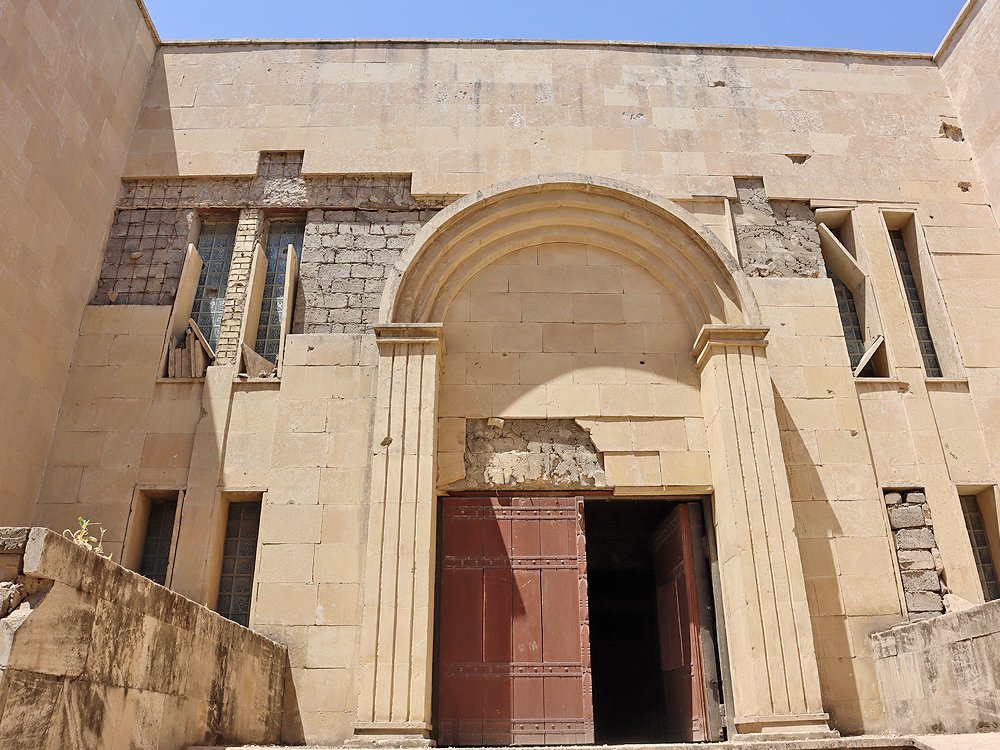Mosul Cultural Museum Reopens, Signifying Hope for Assyrian Cultural Heritage and Triumph Over ISIS Destruction
Source: World Monument Fund. (2019). Mosul Cultural Museum staff documenting the damage in the Assyrian Hall.
The Mosul Cultural Museum, which suffered extensive damage during ISIS's occupation of the city, has announced the launch of its restoration project and unveiled a new exhibition called 'From Destruction to Rehabilitation'. This marks a new chapter in the story of the museum, which was designed by renowned Iraqi architect Mohamed Makiya and first opened in 1952.
During ISIS's control of Mosul from 2014 to 2017, the museum's artefacts were looted and destroyed, including major Assyrian monumental works such as two lamassus, a colossal lion, and tablets engraved with cuneiform verses. In 2015, ISIS released a video showing their destruction of the museum's building and collections, which shocked the world.
Source: World Monument Fund. (2021). Damaged entrance of the Mosul Cultural Museum.
The restoration project is a collaborative effort between the Iraqi State Board of Antiquities and Heritage, the Louvre Museum, the Smithsonian Institution, World Monuments Fund (WMF), and the international alliance for the protection of heritage in conflict areas (ALIPH). Their mission is to restore the museum and its collections, making it a vibrant gathering place that will aid in the city’s post-conflict recovery.
Zaid Ghazi Saadallah, the museum's director, said, "This project will return the Mosul Cultural Museum to its rightful place at the heart of the city and make it a cultural hub for the region." He further explained that the museum tells a story of global importance, including the very beginning of written history, with Nineveh and Mosul being the two names of one entity.
Ariane Thomas, director of the Ancient Near Eastern Antiquities department at the Louvre, recalls the shock at witnessing the images of the museum's destruction. Since then, the Louvre has been working with the Mosul Museum staff to conserve and restore three major stone sculptures, including the lion of Nimrud, as well as other artifacts so that they can be displayed once again.
Source: World Monument Fund. (2022). Artifacts being documented and inventoried.
The rehabilitation project aims to preserve the vision of architect Mohamed Makiya, with some visible damage intentionally left in the central Assyrian gallery as a reminder of the events that took place. Bénédicte de Montlaur, president and CEO of the World Monuments Fund, notes that the Mosul Cultural Museum is "an important historic building" designed by Makiya, and the restoration work will help return it to its rightful place at the heart of the city's identity.
The Mosul Cultural Museum timeline, which traces its history from its inauguration in 1952 to the recent launch of the restoration plan in 2023, illustrates the significance of this project for Assyrian cultural heritage and the people of Mosul. The reopening of the museum represents a triumph over the destruction by ISIS and a renewed sense of hope for the future of Assyrian culture.
Source: World Monument Fund. (2023). Visual of the rehabilitated Assyrian Hall at the Mosul Cultural Museum.
The restoration and reopening of the Mosul Cultural Museum signifies a significant moment in the preservation of Assyrian cultural heritage. This monument, rising from the ashes, represents more than just the physical rebuilding of a museum; it embodies the resilience of a civilization, the triumph of knowledge over destruction, and the unwavering commitment to safeguarding our shared global heritage. As we witness the museum's return to its rightful place at the heart of Mosul, we are reminded of the timeless value of culture, and the significance of preserving our past to enlighten future generations. This momentous event underscores the enduring strength of Assyrian heritage and its indomitable spirit, which continue to inspire and inform humanity's collective memory.
Mosul Cultural Museum: Chronology
The timeline of the Mosul Cultural Museum not only reflects the history of a significant cultural landmark but also highlights the strength and enduring significance of cultural heritage in the face of challenges and adversity.
1952: The original Mosul Museum is unveiled.
1969: Acclaimed Iraqi architect, Mohamed Makiya, is assigned the task of devising the museum’s fresh edifice.
1974: The unveiling of the Makiya-planned Mosul Cultural Museum in its existing structure.
Source: World Monument Fund. (1972). The construction of Mosul Cultural Museum is completed.
2003: A segment of the museum’s collection is relocated to Baghdad.
2014–2017: The city of Mosul is under Daesh control; French President François Hollande advocates for the "Fifty Proposals to Protect the Heritage of Humanity" report.
2015: A video documenting Daesh's demolition of the Mosul Cultural Museum’s edifice and collections is broadcast worldwide.
Source: Mosul Cultural Museum staff documenting the damage in the Assyrian Hall.
2017: The establishment of ALIPH in Geneva (International alliance for the protection of heritage in conflict areas); Mosul city is liberated; The Iraqi army re-establishes control over the museum.
2018: International Consortium of Partners (SBAH, Louvre Museum, Smithsonian Institution, and ALIPH) comes together to formulate plans for the Mosul Cultural Museum Revitalization Project.
2019: The museum's recovery project is initiated, and the action plan is delivered.
Source: World Monument Fund. (2023). Visual of the mezanine floor with view of the main entrance.
2020: The World Monuments Fund (WMF) officially becomes part of the partners as conservation project managers. The remote training of the Mosul Cultural Museum teams is initiated; the documentation of the museum’s objects and library books begins; Artifact restoration commences at the Musée du Louvre.
2021–2022: Planning Phase: WMF organizes a group of architects, landscape architects, engineers, lighting designers, and community engagement professionals;
2022–2023: The Musée du Louvre carries out regular onsite restoration missions. May 11, 2023: The museum's restoration plan is introduced.
May 12–June 1, 2023: A transient exhibition titled "The Mosul Cultural Museum: From Destruction to Rehabilitation" is opened.
Source: World Monument Fund. (1970-72). Mosul Cultural Museum under construction. At the back, we can see the Royal Hall that hosted the museum since 1952 (Between 1970-72).
Source: World Monument Fund. (1970-72). The façade of the Mosul Cultural Museum under construction (Between 1970-72).









